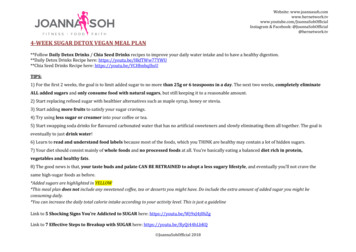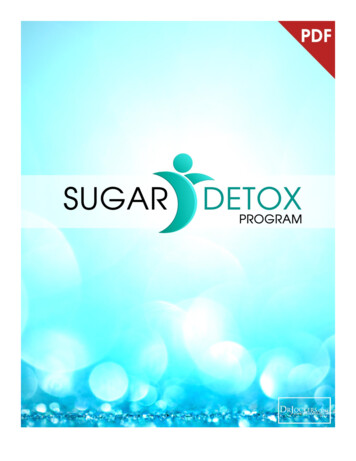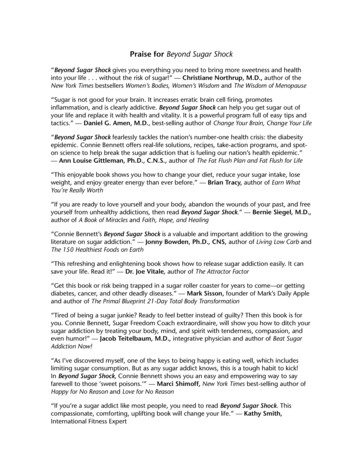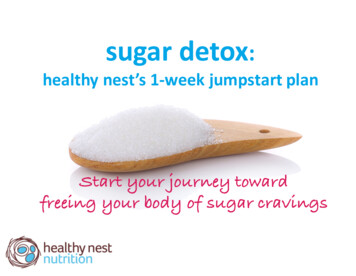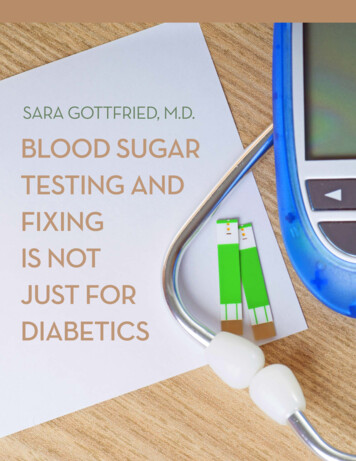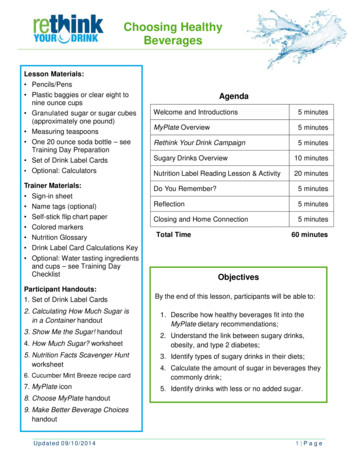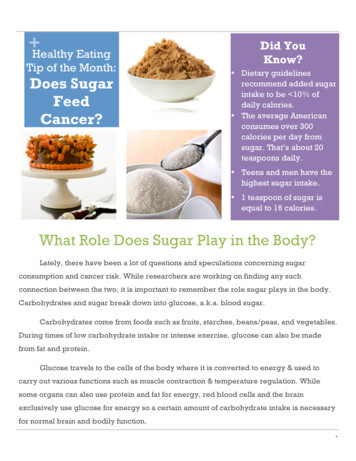
Transcription
Healthy EatingTip of the Month:Does SugarFeedCancer?Did YouKnow? Dietary guidelinesrecommend added sugarintake to be 10% ofdaily calories. The average Americanconsumes over 300calories per day fromsugar. That’s about 20teaspoons daily. Teens and men have thehighest sugar intake. 1 teaspoon of sugar isequal to 16 calories.What Role Does Sugar Play in the Body?Lately, there have been a lot of questions and speculations concerning sugarconsumption and cancer risk. While researchers are working on finding any suchconnection between the two, it is important to remember the role sugar plays in the body.Carbohydrates and sugar break down into glucose, a.k.a. blood sugar.Carbohydrates come from foods such as fruits, starches, beans/peas, and vegetables.During times of low carbohydrate intake or intense exercise, glucose can also be madefrom fat and protein.Glucose travels to the cells of the body where it is converted to energy & used tocarry out various functions such as muscle contraction & temperature regulation. Whilesome organs can also use protein and fat for energy, red blood cells and the brainexclusively use glucose for energy so a certain amount of carbohydrate intake is necessaryfor normal brain and bodily function.1
Does Type of Carbohydrate Make a Difference?Carbohydrate intake affects blood sugar levels. Simple carbohydrates like table sugar,syrup, honey, jams/jellies, fruit/soft drinks, and candies are rapidly digested and increase bloodsugar levels very quickly.Complex carbohydrates are commonly found in foods such as whole grains, starchy orgreen vegetables, beans, & lentils. These foods take longer to digest and create a slow rise inblood glucose levels, which is preferable. A fast increase in blood sugar causes a rapid increasein insulin, which is the hormone responsible for allowing glucose to enter cells. High insulinlevels cause glucose levels to quickly fall, which can then cause you to feel hungry again,prompting you to take in more calories.Consistently high insulin levels can also cause cells to become resistant to insulin,meaning glucose levels stay higher for longer periods. High glucose levels, overweight/obesity,and inactivity can all increase the risk for diabetes and heart disease. Research has linkeddiabetes and obesity to cancers of the liver, pancreas, endometrium, colon and rectum, andbladder. To help reduce the risk of Type 2 Diabetes, heart disease, and help with weightmanagement, studies have shown a benefit to following a low-glycemic index diet, which isdescribed on the next page.2
A Closer Look at the Glycemic IndexThe glycemic index (GI) is a ranking of foods on a scale of 0-100 according to how much they raiseblood sugar levels. High-GI foods are digested rapidly and raise blood sugar levels quickly whereas lowGI foods are more slowly digested and produce a gradual raise in glucose and insulin levels in the blood.Products with sugar, corn syrup, molasses, and hidden sugars (ingredients ending in -ose) usually indicatea high-GI food. The less processed a product is, the lower the GI will be. These foods usually have morefiber, which helps to delay digestion and also contain more vitamins, minerals and cancer-fightingphytochemicals.Sugary beverages like pop, energy or sports drinks, & sweetened teas/coffees are considered highGI products. These drinks are high in calories so they can cause weight gain if consumed often. Betterbeverage choices include water, unsweetened tea, vegetable juices, and milk since they have a low GI andcontain other nutrients. Remember to opt for whole fruits & vegetables as they offer more fiber, cause lessof an increase in blood sugar, and help to control hunger better than juice forms.For more information on the glycemic index, please visit www.glycemicindex.com.3
Many “diet” or “low-calorie” products use non-nutritive artificialsweeteners in place of natural sugar because they don’t contain calories.Artificial sugars have the potential to help with weight control and diabetessince these products are low-calorie and do not raise blood sugar levels.However, some research suggests that consuming artificial sugars may beA WordAboutArtificialSugarsassociated with weight gain because they can cause a pseudo-effect thatreleases insulin into the blood as the body believes glucose levels will be rising. With noglucose for the uptake, the body may be led to feel hunger and cause you to eat more inorder to replenish that glucose. There have also been questions regarding artificial sugarsand cancer, but according to the National Cancer Institute, there is no sound scientificevidence linking the two. The Food and Drug Administration regulates artificial sugars andhas provided acceptable daily intake levels for safe consumption.Pulling It All Together: Maintain a healthy weight: Limit excessive abdominal fat to reduce insulinresistance and risk of diabetes and heart disease. Get up and MOVE! Exercise is a great way to decrease insulin resistance and,when paired with an overall healthy diet, can help you maintain a healthy weight.Go for a walk, go bike riding, mow the lawn – do something that gets your heartrate up! Balance total carbohydrate intake: Find foods that have a lower GI since thesefoods usually have additional nutritional benefits. Pair carbohydrates with leanprotein to help increase satiety and control appetite. Try to fill ½ your plate with vegetables and fruit, ¼ with starches (whole grains orpotatoes), and ¼ with lean protein in order to help maintain healthy blood sugarlevels. It is important to note that although fruits do contain natural sugar, they alsocome with added benefits of fiber, vitamins, minerals, and phytochemicals, whichmake them part of a healthy icial-sweeteners/art-20046936Created By: Ana Trivax,Dietetic Intern
Healthy SmoothieRecipesBerry BananaSmoothieIngredients:1 frozen sliced banana½ cup fresh orange juice1 cup hulled strawberries1 cup blackberries1 ¾ cups fat free plain GreekyogurtDirections:Place all ingredients in ablender, process until smooth.Nutrition:Calories: 138; Fat: 0.4 g; Carb:25 g; Fiber: 3.4 g; Protein: 9.8gApple Pie SmoothieIngredients:1 medium apple, cored &chopped1 cup fat-free milk⅓ cup oats2 teaspoons maple sugar½ teaspoon ground cinnamonDirections:Place all ingredients in a heavyduty blender and blend untildesired consistency isachieved. Serve in a glass withadditional cinnamon sprinkledon top. Makes 2 servings.Nutrition per serving:Calories: 170; Fat: 1 g; Fiber: 4g; Carb: 33 g; Protein: 7 gPear VanillaSmoothieIngredients:1 ripe pear, cored and sliced1 scoop vanilla protein powder1 cup fat-free milk1-2 handfuls of ice cubesAdditional water to aid blendingif necessaryOptional: 1 handful of fresh babyspinachDirections:In a blender, combine pear,protein powder, liquid, ice andspinach (if using). If the mixture istoo thick, add additional water orice.Nutrition: Calories: 249; Fat: 2 g;Fiber: 6 g; Carb: 43 g; Protein: 19g5
Smoothies are a tasty and fun way to add fruit and evenvegetables into your diet. Great as a dessert as well as ameal, these low sugar added recipes are bountiful inantioxidants, vitamins, and minerals and are sure to satisfyany sweet tooth!Peanut Butter Berry SmoothieIngredients:¼ cup 1% low fat milk½ medium ripe banana, sliced1 tablespoon creamy peanut butter1 cup fresh or frozen raspberries½ cup crushed iceDirections: Place all ingredients in a blender, process until smooth.Nutrition: Calories: 236; Fat: 9.6g; Carb: 34g; Fiber 10.5g; Protein: 8 gCranberry Apple SmoothieIngredients:1 cup fresh or frozen cranberries1 stalk celery, chopped1 sweet apple variety, medium size, peeled and chopped3 inches of medium-sized cucumber, peeled and chopped¼ cup water and several ice cubesDirections: Place all ingredients in the blender and process until smoothNutrition: Calories: 124; Fat: 0g: Fiber: 9g; Carb: 32 g; Protein: 1 gMango and Coconut SmoothieIngredients:2 mangos, peeled and chopped then frozen (or 2 cups cut frozen mangos)1 orange, peeled1 raw carrot, chopped or shredded¼ cup cashews, soaked at least an hour or overnight then drained1½ cups coconut water1 teaspoon turmeric (fresh, dried, ground, or powder)1 teaspoon freshly grated gingerDirections: Place all ingredients in a blender. Blend until smooth. Makes 2smoothiesNutrition per serving: Calories: 272; Fat: 8 g; Carb: 51 g; Fiber: 7 g; Protein: -Apple-Pie-Smoothie/6
scrumptious desserts are mouth watering Theseand easy on the waistline!Mint-Melon PopsIngredients:1-1/2 cup cantaloupe chunks1 tbsp orange juice1-1/2 cup honeydew chunks1 tbsp limeade concentrate, thawed2 mint leavesDirections:In a blender, puree cantaloupe and orange juice until smooth. Divide the mixture among six popmolds or paper cups. Freeze until firm, about 30 minutes.Puree the honeydew, limeade, and mint. Remove the molds from the freezer and top withhoneydew mixture. Cover and freeze until firm.Nutrition per pop: Calories: 36; Fat: 0g; Carb: 9 g; Fiber 1g; Protein: 0 g.Mango SorbetIngredients:2 very ripe mangoes (2-2 ½ pounds), peeled, cut into ½-inch chunksand frozen2 tbsp unsweetened coconut flakes1 small line, quarteredHoney for drizzlingDirections:Preheat the oven to 350ºF. Spread the coconut on a baking sheet, andbake until lightly golden and toasted, about 4 minutes, tossing half-way through.Place frozen mango in a food processor. Add ¼ to ½ cup hot water, and process the mango untilcompletely smooth; turn the food processor off and stir with a wooden spoon or spatula asneeded. The finished texture should be like creamy sorbet.Scoop the sorbet into 4 bowls, squeeze a quarter of a lime over each, drizzle with honey andsprinkle with toasted coconut.Nutrition per serving: Calories: 120; Fat: 2.5 g; Carb: 26 g; Fiber3g; Protein: 2 pes/mint-melon-popsPatient Food and Nutrition Services300 N. Ingalls StreetNIB NI8E20Ann Arbor, MI 48109-5407734-936-5197Created By: Ana Trivax, Dietetic7
blood sugar levels. High-GI foods are digested rapidly and raise blood sugar levels quickly whereas low-GI foods are more slowly digested and produce a gradual raise in glucose and insulin levels in the blood. Products with sugar, corn syrup, molasses, and hidden sugars (ing
